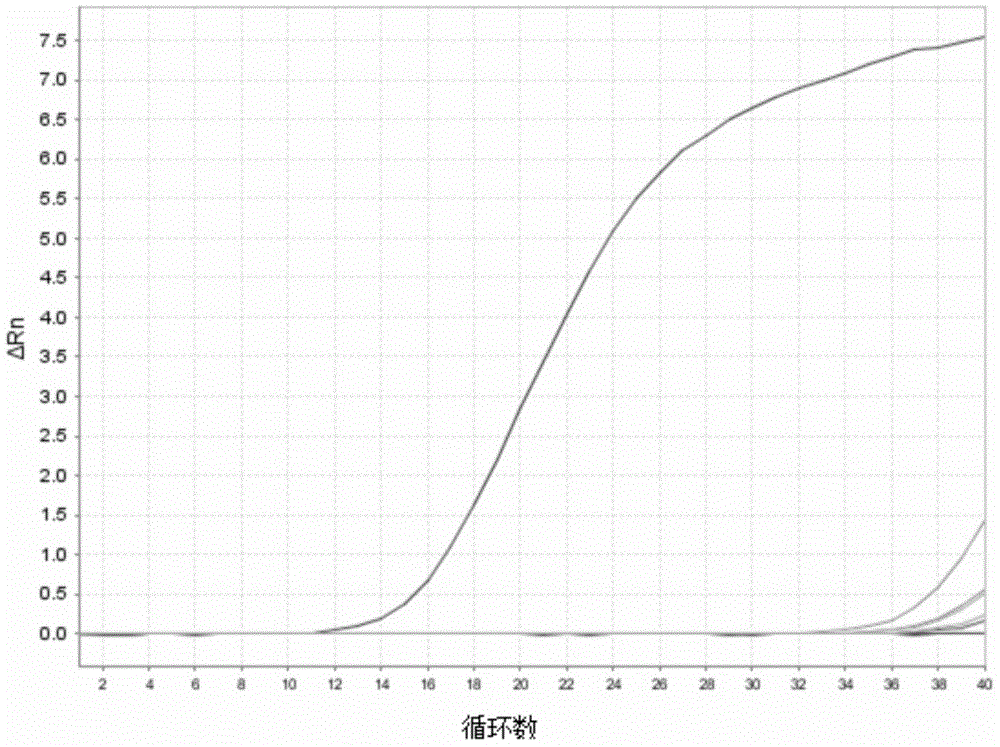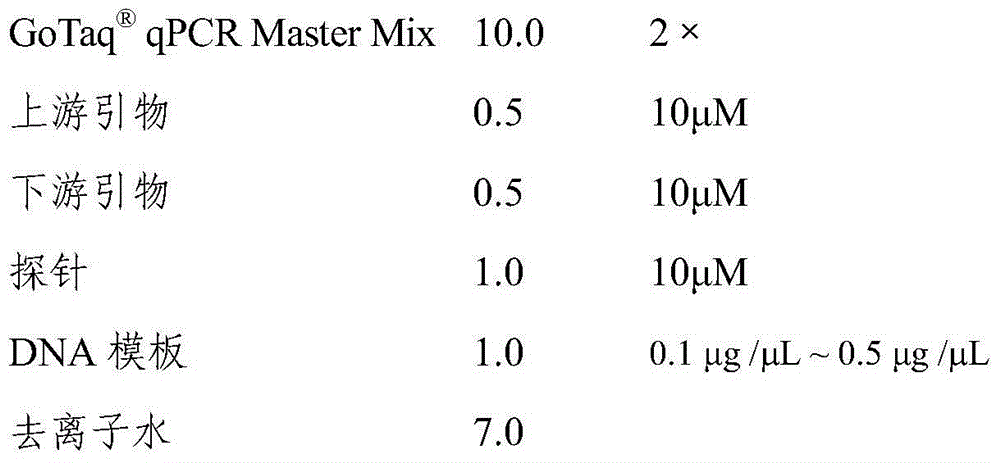Kit for detecting rabbit-derived components in food and application of kit
A rabbit-derived, kit-based technology, used in the determination/inspection of microorganisms, DNA/RNA fragments, recombinant DNA technology, etc., can solve the problem that the fluorescent PCR method for the detection of rabbit-derived components has not yet been reported, and achieve good detection. The effect of the ability, sensitivity and accuracy of rabbit-derived ingredients in food
- Summary
- Abstract
- Description
- Claims
- Application Information
AI Technical Summary
Problems solved by technology
Method used
Image
Examples
Embodiment 1
[0023] The design of embodiment 1 primer
[0024] After a large number of comparisons of the COX 1 gene in GenBank, the highly conserved and species-specific gene sequence of the COX 1 gene was selected as a template, and the upstream and downstream primers and probes specific to rabbit COX 1 were designed. The main feature is that the length of the upstream and downstream primers is 17bp And 24bp nucleotides, the probe length is 26bp nucleotides, and the 5' end is labeled with a FAM fluorescent group, and the 3' end is labeled with a TAMRA quencher group. The sequence is as follows:
[0025] Upstream primer: 5`-CTGCATGGCGGCAACAT-3`(SEQ ID NO.1)
[0026] Downstream primer: 5`-AATTCCTGTAAGACCGCCTACTGT-3`(SEQ ID NO.2)
[0027] Fluorescent probe: 5`-FAM-AAATGATCCCCCGCTATGCTCTGAGC-TAMRA-3`(SEQ ID NO.3)
Embodiment 2
[0028] The establishment of embodiment 2 fluorescence quantitative PCR detection method
[0029] 1. Extract sample DNA
[0030] (1) Take 0.2g of rabbit meat sample and cut it into pieces as much as possible. Place in a 1.5ml centrifuge tube, add 1ml of cell lysis buffer, 20μl proteinase K (500μg / ml), and mix well. Water-bath in a constant temperature water bath at 65°C for 30 minutes, and shake the centrifuge tube several times intermittently. Centrifuge at 12,000 rpm for 5 minutes in a tabletop centrifuge, and transfer the supernatant to another centrifuge tube.
[0031] (2) Add an equal volume of phenol:chloroform mixture (1:1), shake and mix, and centrifuge at 12,000 rpm for 10 min.
[0032] (3) Take the supernatant to another tube, add an equal volume of chloroform, shake and mix, and centrifuge at 12,000 rpm for 10 min.
[0033] (4) Take the supernatant to another tube, add 1 / 10 volume of 3mol / L sodium acetate and 2 times the volume of absolute ethanol, mix well, sett...
Embodiment 3
[0045] Embodiment 3 specificity test
[0046] In order to verify the specificity of this kit, the genomic DNA of rabbits was used as a positive control, the DNA of 15 species such as pigs, cattle, and sheep were used as detection objects, and dd H 2 O is a blank control, and the fluorescent quantitative PCR detection system established in Example 2 is used to detect the above 16 species. After the amplification was completed, the same threshold was taken to analyze the data after deducting the background fluorescence signal, and the Ct value of each sample was determined. The experimental results are shown in Table 1. The Ct value of the rabbit is 15.31, showing a positive result, while the CT values of the other 15 species are all greater than 35, showing a negative result. This experiment proves that the kit has good species specificity.
[0047] Table 1 The inventive method is to the detection result of 16 kinds of animal DNAs
[0048] species
PUM
 Login to View More
Login to View More Abstract
Description
Claims
Application Information
 Login to View More
Login to View More - R&D
- Intellectual Property
- Life Sciences
- Materials
- Tech Scout
- Unparalleled Data Quality
- Higher Quality Content
- 60% Fewer Hallucinations
Browse by: Latest US Patents, China's latest patents, Technical Efficacy Thesaurus, Application Domain, Technology Topic, Popular Technical Reports.
© 2025 PatSnap. All rights reserved.Legal|Privacy policy|Modern Slavery Act Transparency Statement|Sitemap|About US| Contact US: help@patsnap.com



